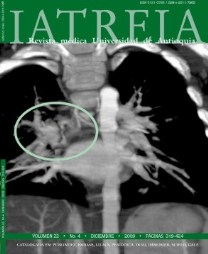Functional neurological evaluation of the brainstem. Part I: the blink reflex
DOI:
https://doi.org/10.17533/udea.iatreia.11112Abstract
The blink reflex is the neural response elicited in the orbicular oculi muscle after single or paired supraorbital nerve stimulation, by either electrical, mechanical, acoustic, thermal, chemical or magnetic stimulation. It is made up of three responses called R1, R2 and R3. R1 is an early response that follows A beta fibers, and does not habituate. R2 is a middle-latency response that follows A beta and A delta fibers, tends to habituate and is modulated by sensorimotor suprasegmental structures.
R3 is a long-latency response, generated by stimulation of a multisynaptic chain of neurons that involve type C fibers belonging to a complex pontothalamic-amigdalo-cerebellar pathway. It is also possible to record three silent periods if the blink reflex is obtained while the subject makes a voluntary facial muscle effort.
The functional study of this reflex allows to define with certainty whether the lesion is in afferent or efferent pathways or if it involves an abnormal sensorimotor integration due to disorders of the central, autonomic or peripheral nervous systems. A correct execution of these studies, and their appropriate interpretation, based on the underlying mechanisms of neural plasticity, will guide toward better neurorehabilitation protocols.
Downloads
Downloads
Published
How to Cite
Issue
Section
License
Papers published in the journal are available for use under the Creative Commons license, specifically Attribution-NonCommercial-ShareAlike 4.0 International.
The papers must be unpublished and sent exclusively to the Journal Iatreia; the author uploading the contribution is required to submit two fully completed formats: article submission and authorship responsibility.














